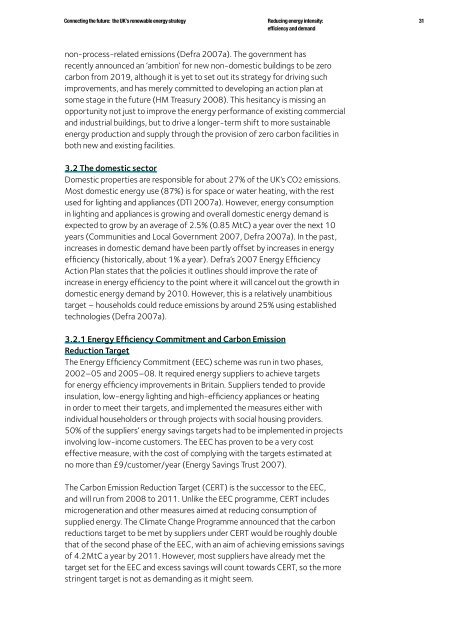Connecting the Future - Greenpeace UK
Connecting the Future - Greenpeace UK
Connecting the Future - Greenpeace UK
You also want an ePaper? Increase the reach of your titles
YUMPU automatically turns print PDFs into web optimized ePapers that Google loves.
<strong>Connecting</strong> <strong>the</strong> future: <strong>the</strong> <strong>UK</strong>’s renewable energy strategy<br />
Reducing energy intensity:<br />
efficiency and demand<br />
31<br />
non-process-related emissions (Defra 2007a). The government has<br />
recently announced an ‘ambition’ for new non-domestic buildings to be zero<br />
carbon from 2019, although it is yet to set out its strategy for driving such<br />
improvements, and has merely committed to developing an action plan at<br />
some stage in <strong>the</strong> future (HM Treasury 2008). This hesitancy is missing an<br />
opportunity not just to improve <strong>the</strong> energy performance of existing commercial<br />
and industrial buildings, but to drive a longer-term shift to more sustainable<br />
energy production and supply through <strong>the</strong> provision of zero carbon facilities in<br />
both new and existing facilities.<br />
3.2 The domestic sector<br />
Domestic properties are responsible for about 27% of <strong>the</strong> <strong>UK</strong>’s CO2 emissions.<br />
Most domestic energy use (87%) is for space or water heating, with <strong>the</strong> rest<br />
used for lighting and appliances (DTI 2007a). However, energy consumption<br />
in lighting and appliances is growing and overall domestic energy demand is<br />
expected to grow by an average of 2.5% (0.85 MtC) a year over <strong>the</strong> next 10<br />
years (Communities and Local Government 2007, Defra 2007a). In <strong>the</strong> past,<br />
increases in domestic demand have been partly offset by increases in energy<br />
efficiency (historically, about 1% a year). Defra’s 2007 Energy Efficiency<br />
Action Plan states that <strong>the</strong> policies it outlines should improve <strong>the</strong> rate of<br />
increase in energy efficiency to <strong>the</strong> point where it will cancel out <strong>the</strong> growth in<br />
domestic energy demand by 2010. However, this is a relatively unambitious<br />
target – households could reduce emissions by around 25% using established<br />
technologies (Defra 2007a).<br />
3.2.1 Energy Efficiency Commitment and Carbon Emission<br />
Reduction Target<br />
The Energy Efficiency Commitment (EEC) scheme was run in two phases,<br />
2002–05 and 2005–08. It required energy suppliers to achieve targets<br />
for energy efficiency improvements in Britain. Suppliers tended to provide<br />
insulation, low-energy lighting and high-efficiency appliances or heating<br />
in order to meet <strong>the</strong>ir targets, and implemented <strong>the</strong> measures ei<strong>the</strong>r with<br />
individual householders or through projects with social housing providers.<br />
50% of <strong>the</strong> suppliers’ energy savings targets had to be implemented in projects<br />
involving low-income customers. The EEC has proven to be a very cost<br />
effective measure, with <strong>the</strong> cost of complying with <strong>the</strong> targets estimated at<br />
no more than £9/customer/year (Energy Savings Trust 2007).<br />
The Carbon Emission Reduction Target (CERT) is <strong>the</strong> successor to <strong>the</strong> EEC,<br />
and will run from 2008 to 2011. Unlike <strong>the</strong> EEC programme, CERT includes<br />
microgeneration and o<strong>the</strong>r measures aimed at reducing consumption of<br />
supplied energy. The Climate Change Programme announced that <strong>the</strong> carbon<br />
reductions target to be met by suppliers under CERT would be roughly double<br />
that of <strong>the</strong> second phase of <strong>the</strong> EEC, with an aim of achieving emissions savings<br />
of 4.2MtC a year by 2011. However, most suppliers have already met <strong>the</strong><br />
target set for <strong>the</strong> EEC and excess savings will count towards CERT, so <strong>the</strong> more<br />
stringent target is not as demanding as it might seem.




![[2007] EWHC 311 - Greenpeace UK](https://img.yumpu.com/22079793/1/184x260/2007-ewhc-311-greenpeace-uk.jpg?quality=85)











